![]()
![]()
![]()
Use LEFT and RIGHT arrow keys to navigate between flashcards;
Use UP and DOWN arrow keys to flip the card;
H to show hint;
A reads text to speech;
205 Cards in this Set
- Front
- Back
|
The distribution of freshwater taxa is dependent on what factors? |
1. physical 2. chemical 3. biological |
|
|
What is the major physical factor that the distribution of freshwater taxa depend on? |
water velocity |
|
|
Flowing waters such as springs, rivers, streams, and karst are called....? |
lotic |
|
|
Standing water such as ponds, lakes, vernal pools, and reservoirs are called....? |
lentic |
|
|
Give 4 examples of lotic systems. |
1. springs 2. rivers 3. streams 4. karst |
|
|
Give 4 examples of lentic systems. |
1. ponds 2. lakes 3. vernal pools 4. reservoirs |
|
|
Name 2 types of freshwater habitats that don't fall under the lotic nor lentic categories. |
estuaries and bayous |
|
|
What are bayous? |
lotic systems with some lentic qualities |
|
|
What are estuaries? |
the intersection of saltwater and freshwater |
|
|
Name 2 ways lentic systems are stratified |
1. by light 2. by temperature |
|
|
Name the 2 zones in light stratification |
1. photic zone (where photosythesis can occur) 2. aphotic zone (where it can't.) |
|
|
Why does temperature stratification occur? |
cold water is denser and typically rests at the bottom |
|
|
In which seasons would a thermocline be evident? (double check this) |
winter and summer |
|
|
In which season would the highest O2 concentration be in the middle? |
winter |
|
|
Name 6 general characteristics of lotic systems |
1. turbulent 2. no stratification 3. generally well oxygenated 4. fairly uniform temperature 5. high habitat heterogeneity 6. influenced by allochthonous inputs |
|
|
The descriptive term for the position of a stream within watersheds relative to tributaries is...? |
stream order |
|
|
Name the the 2 methods for determining stream order |
1. Strahler Method 2. Shreve Method |
|
|
Which method is best for determining stream order and why? |
Shreve, because it takes overall discharge into account |
|
|
Which method for determining stream order is the most commonly used? |
Strahler Method |
|
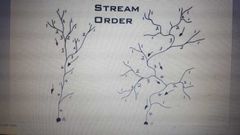
Which method is this? |
Strahler |
|
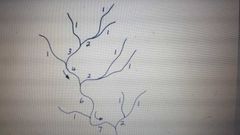
Which method is this? |
Shreve Method |
|
|
Terms like "meandering" and "braiding" describe....? |
channel pattern |
|
|
What patterns determine the formation of channel units? |
patterns of erosion and deposition |
|
|
Name the 2 main types of channel units |
riffles and pools |
|
|
Riffles are erosional during (blank) flow |
normal |
|
|
Riffles are depositional during (blank) flow. |
high |
|
|
Pools are erosional during (blank) flow. |
high |
|
|
Pools are depositional during (blank) flow |
normal |
|
|
Define thalweg |
The main line of flow through a channel, usually the deepest part of the channel, and creates the stream meander. |
|
|
What is the term for bottom-dwelling inverts? |
benthic inverts |
|
|
Why are most freshwater inverts benthic? |
Substrate provides refuge from the water current, predators, and competitors. |
|
|
Name the 4 main types of benthic subtrate |
1. boulders and cobbles 2. gravel 3. sand 4. silt |
|
|
What are the 3 main ways diversity is influenced by chemistry? |
1. dissolved oxygen 2. salinity 3. pH |
|
|
Name the 6 main functional feeding groups |
1. shredders 2. collectors 3. scrapers 4. predators 5. piercers 6. parasites |
|
|
What is the food of collectors? |
living and decomposing plant tissue |
|
|
What is the food of collectors? |
FPOM (fine particulate organic matter) |
|
|
What is the food of scrapers? |
periphyton |
|
|
What is the food of predators? |
whole animals, animal tissue |
|
|
What is the food of piercers? |
living hydrophytes |
|
|
What is the food of parasites? |
living animal and plant tissue |
|
|
How do shredders obtain their food? |
chewing wood and CPOM (coarse particulate organic matter) |
|
|
How do collectors obtain their food? |
filtering and/or gathering |
|
|
How do scrapers obtain their food? |
rasping and scraping |
|
|
How do predators obtain their food? |
engulfing/piercing |
|
|
How do piercers obtain their food? |
sucking |
|
|
How do parasites obtain their food? |
invasion |
|
|
The "Upper Reaches" of a stream refer to....? |
headwater to 3rd order streams |
|
|
The "Middle Reaches" of a stream refer to....? |
orders 4-6 |
|
|
The "Lower Reaches" of a stream are....? |
order 7+ |
|
|
Which class of Porifera is mostly marine but is still the only class with freshwater species? |
Demospongiae |
|
|
Most Porifera species in North America are in which class? |
Spongillidae |
|
|
Most sponges prefer what type of substrate? |
hard substrates such as rocks, plants, or logs |
|
|
All sponges are what type of feeders? |
filter feeders |
|
|
Porifera gametes are formed by...? |
amoebocytes |
|
|
Name the 2 ways Porifera asexually reproduces |
1. budding 2. gemmules |
|
|
What structures do cnidarians use to feed? |
tentacles and nematocysts |
|
|
Give some examples of what cnidarians eat |
plankton such as cladocerans, rotifers, and copepods |
|
|
Even though cnidarians prefer eutrophicated waters, they are intolerant of...? |
heavy metals |
|
|
Name the only introduced species of freshwater jellyfish in North America |
Craspedacusta sowberii (from Asia) |
|
|
In what phylum are flatworms? |
Platyhelminthes |
|
|
What type of body plan do Turbellarians have? |
acoelomate |
|
|
How do Turbellarians respire? |
cutaneous |
|
|
Name the 3 general types of locomotion seen in Turbellarians |
1. swimming via cilia 2. swimming or crawling via peristaltic action of muscles 3. leech-like looping movements in some terrestrial species |
|
|
Is fertilization internal or external in turbellarians? |
internal |
|
|
Is development direct or indirect in freshwater turbellarians? |
direct |
|
|
In what ways do turbellarians asexually reproduce? |
fragmentation and regeneration |
|
|
What 2 types are turbellarians divided into? |
1. microturbellarians 2. macrotubellarians |
|
|
The Planarians fall into which turbellarian category? Which order are they in? |
category: Macroturbellarians order: Tricladida |
|
|
Describe the functional role of turbellarians in the ecosystem |
eaten by a variety of invertebrates and vertebrates, but are usually only a small part of the diet |
|
|
How do Nemerteans differ from Turbellarians? |
1. they have a circulatory system 2. complete digestive system 3. eversible proboscis (turbellarians have eversible pharynx) |
|
|
There is only one genus of Nemertea in North America. What is it? |
Prostoma |
|
|
The single most important character in Nemerteans are their |
eversible proboscis |
|
|
All Nemerteans are predators and feed on |
oligochaetes, crustaceans, nematodes, and turbellarians |
|
|
Reproduction in Nemerteans is |
sexual |
|
|
What is the body plan of Gastrotrichans? |
pseudocoelomate |
|
|
What do Gastrotrichans feed on? |
bacteria, algae, protozoans, and detritus |
|
|
Are most rotifers freshwater or marine? |
freshwater |
|
|
Which phylum has a corona with cilia? |
Rotifera |
|
|
True or false: Rotifers are covered in cilia |
false; only on the corona |
|
|
What is the purpose of Rotifers' forked foot? |
attachment to substrate |
|
|
True or false: nematodes can be parasitic OR free-living |
true |
|
|
How do nematodes respire? |
simple diffusion |
|
|
Are nematodes monoecious or dioecious? |
dioecious |
|
|
Guinea worms (Dracunculus medinensis) are transmitted by...? |
copepods from unfiltered drinking water |
|
|
Which type of Gastropods evolved from marine ancestors? |
Operculate snails |
|
|
Which type of Gastropods evolved from terrestrial and semi-aquatic ancestors? |
Freshwater pulmonates |
|
|
What is the purpose of torsion? |
excretion |
|
|
What process do Gastropods undergo to aid in excretion? |
torsion |
|
|
What is the function of the radula? |
scraping |
|
|
Gastropods account for up to what percentage of the total biomass of southeastern streams? |
95% |
|
|
Name the 5 Gastropod families in the Operculate group |
1. Pleuroceridae 2. Viviparidae 3. Hydrobiidae 4. Valvatidae 5. Pomatiopsidae |
|
|
Name the 4 Gastropod families in the Pulmonate group |
1. Physidae 2. Lymnaidae 3. Planorbidae 4. Ancyclidae |
|
|
What form of reproduction do most operculate snail families exhibit? |
oviparous |
|
|
Which snail families are ovoviviparous? |
Viviparidae and some Hydrobiidae |
|
|
Which family of snails is the only monoecious one? |
Valvatidae |
|
|
Species with a one-year life cycle are referred to as (blank 1.) only reproduce (blank 2.) and exhibit (blank 3.) |
1. annual 2. once 3. semelparity |
|
|
Species that may live 4-5 years and reproduce each year are considered (blank 1.) and exhibit (blank 2.) |
1. perennial 2. iteroparity |
|
|
What word describes having seperate sexes? |
dioecious |
|
|
What word describes being hermaphroditic? |
monoecious |
|
|
Most snails are dioecious - true or false? |
true |
|
|
Campeloma can reproduce either sexually or ....? |
parthenogenically |
|
|
Give 3 general characteristics of Pulmonates |
1. lack an operculum 2. thin shells 3. mainly restricted to lentic or slow flowing habitats |
|
|
Which Pulmonate families breathe via a lung? |
Physidae and Lymnaidae |
|
|
Which Pulmonate families breathe via epithelial tissue of the mantle? |
Ancyclidae and Planorbidae |
|
|
Describe how Physidae and Lymnaidae breathe |
via a lung; must come to surface to breathe, therefore restricted to shallow water |
|
|
Describe how Ancylidae and Planorbidae breathe |
via epithelial tissue of the mantle |
|
|
Give 4 general characteristics of Operculates |
1. have an operculum 2. breathe via a gill 3. thick shells 4. mainly restricted to lotic habitats |
|
|
Oviparous pulmonates are always....? |
hermaphrodites |
|
|
What type of life cycle do Pulmonates usually exhibit? |
annual and semelparous |
|
|
Name the 5 most important lentic families of Gastropods |
1. Planorbidae 2. Lymnaidae 3. Physidae 4. Viviparidae 5. Ancylidae |
|
|
Name the 4 most important lotic families of Gastropods |
1. Pleuroceridae 2. Hydrobiidae 3. Viviparidae (both lotic and lentic) 4. Ancylidae (both lotic and lentic) |
|
|
Name the 4 limiting factors for Gastropods |
1. calcium carbonate 2. pH 3. oxygen 4. temperature |
|
|
Oxygen is less of a limiting factor in which snail group? |
pulmonates since they rely on atmospheric oxygen |
|
|
Left handed snails are called |
sinistral |
|
|
Right handed snails are called |
dextral |
|
|
Name 3 sinistral snail families |
1. Physidae 2. Planorbidae 3. Ancylidae |
|
|
Which snail family exhibits the highest diversity and endemism? |
Hydrobiidae |
|
|
Why was Corbicula introduced? |
food |
|
|
How has Corbicula had an economic impact in North America? |
clogs filters and water intake devices of power and water treatment plants |
|
|
How has Corbicula affected native fauna? |
1. taking up available habitat 2. competing for food 3. eating sperm of native species |
|
|
Which has caused more serious problems - Corbicula or Dreissena? |
Dreissena |
|
|
Name 5 factors influencing Bivalve distribition |
1. substrate 2. pH 3. calcium carbonate 4. dissolved oxygen 5. temperaturs |
|
|
What percentage of Bivalves are of some sort of conservation concern? |
70% |
|
|
How many Bivalve species are presumed extinct? |
35 |
|
|
Name 3 causes of species loss in Bivalves |
1. habitat degradation and loss 2. invasive species 3. loss of fish hosts |
|
|
Describe 3 ways habitat degradation has affected Bivalve numbers? |
1. impoundment and water level fluctuations 2. acid mine drainage altering pH 3. sedimentation |
|
|
Name 4 ecological functions of bivalves |
1. mussels filter large volumes of water 2. bioturbation 3. create habitat 4. major food source for other organisms |
|
|
What do mussels feed on? |
FPOM, bacteria, plankton |
|
|
How do mussels create habitat for other organisms? |
shells are often substrates for insects, madtoms, snails, etc |
|
|
What is another word for the gills of Bivalves? |
ctenidia |
|
|
Name 3 functions of gills (ctenidia) in bivalves |
1. respiration 2. feeding 3. reproduction |
|
|
True or false: most bivalves are monoecious |
false; most are dioecious |
|
|
What are bivalve larva called? |
glochidia |
|
|
Long term brooders are called |
bradytictic |
|
|
Name the 2 reproductive strategies of bivalves |
1. Bradytictic 2. Tachytictic |
|
|
Define tachytictic |
short term brooders |
|
|
Name 5 host attraction strategies of bivalves |
1. mantle lures 2. conglutinates 3. amorphous conglutinates 4. super conglutinates 5. host capture |
|
|
The layer between warm and cold water is called |
thermocline |
|
|
Will you find more biodiversity in lotic or lentic systems? |
lotic |
|
|
Inputs coming from outside the system are called |
allochthonous |
|
|
Bed material grain size (blank) downstream toward drainage |
decreases |
|
|
Discharge (blank) downstream toward drainage |
increases |
|
|
width and depth of a stream (blank) downstream toward drainage |
increase |
|
|
A riffle is (blank) at times of high flow but is normally (blank 2. |
1. depositional at high flow 2. erosional normally |
|
|
A pool is (blank) at high flow but is normally (blank 2.) |
1. erosional at high flow 2. deposotional normally |
|
|
Define thalweg |
where most of the stream's energy is |
|
|
High gradient streams like headwater have larger or smaller substrate? |
larger |
|
|
Does substrate size increase or decrease as gradient decreases |
substrate gets smaller/decreases as gradient decreases |
|
|
Upstream where the organic matter is coarse, what groups of inverts will you find? |
mostly collectors and shredders; a few grazers and predators |
|
|
Downstream where organic matter is fine, what groups of inverts will you find? |
mostly collectors and grazers; a few shredders and predators |
|
|
Between upstream and downstream, what groups of inverts will you find? |
collectors, grazers, and predators |
|
|
What force causes stream meandering? |
thalweg |
|
|
Most energy input for the upper reaches of a stream (headwater to 3rd order) comes from: |
allochthonous detritus / coarse particulate organic matter |
|
|
What provides energy to shredders in the upper reaches (headwater to 3rd order) of a stream? |
microorganisms growing on surface of CPOM |
|
|
Will there be more photosynthesis in the upper, middle, or lower reaches of a stream and why? |
middle because in headwaters, riparian vegetation shades the water and in the lower reaches the water is deep and cloudy |
|
|
As slope of the basin decreases downstream, what increases? |

1. channel width 2. channel depth 3. flow velocity 4. volume of stored alluvium 5. stream discharge |
|
|
What decreases as slope of the basin decreases? |
bed material grain size |
|
|
Why is diversity influenced by water temp? |
warmer temp means less dissolved oxygen |
|
|
Why does the proportion of predators remain the same from upper to lower reaches? |
Their numbers are dependent on the numbers of any of the other invertebrate feeding groups |
|
|
How many drainages are in KY? |
17 |
|
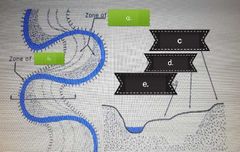
a? |
deposition |
|
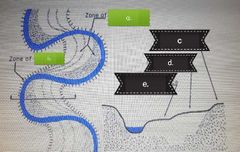
b? |
erosion |
|
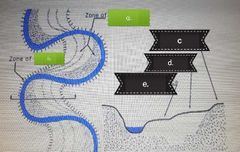
c? |
upland terrace |
|

d? |
middle terrace |
|
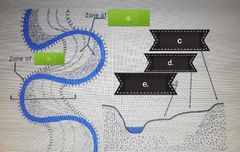
e? |
floodplain terrace |
|
|
The deepest part of the channel is usually the |
thalweg |
|
|
How is diversity influenced by disturbance? |
Intermediate disturbance hypothesis states that diversity is highest with a moderate (not too high or low) amount of disturbance. |
|
|
How is diversity influenced by stream position? |
The River Continuum Concept states that community composition is influenced by the prosition within a river system, because streams are heavily influenced by photosynthesis and allochthonous inputs processed by organisms |
|
|
Gemmules occur only in |
freshwater sponges |
|
|
Groups of food laden amoebocytes are called |
gemmules |
|
|
How are gemmules formed? |
environmental triggers such as decreases temps |
|
|
How does budding in Porifera work? |
body wall is fragmented and buds appear on sides of sponge; at a certain size they will fall off and settle at bottom to form a new sponge |
|
|
Hydras have a larval polyp stage: true or false? |
false; hydras have no larval stage |
|
|
True or false: Cnidarians can change sex |
true; environmental conditions can lead to changing sex |
|
|
What do turbellarians use for excretion? |
flame cells |
|
|
True or false: turbellarians can change sex |
true |
|
|
True or false: the presence of turbellarians can be an indication of water quality |
false; found in all sorts of waters |
|
|
Are turbellarians found in lotic or lentic habitats? |
both, but generally not in very fast moving water |
|
|
Both Corbiculidae and Sphaeridae have what type of fertilization? |
internal |
|
|
Which Bivalve family exhibits maternal care? |
Corbiculidae |
|
|
How does maternal care work in Corbiculidae? |
trochophore larvae develop inside the female so there is no free swimming stage |
|
|
True or false: most Corbiculids are dioecious |
false; most are monoecious/hermaphroditic |
|
|
How do Sphaerids develop? |
direct; in gills |
|
|
Which Bivalves have the highest filtering rate? |
Dreissena |
|
|
Explain how Bradytictic bivalves reproduce |
1. glochidia develop in gills from late fall-early spring 2. glochidia released in spring |
|
|
Explain how Tachytictic bivalves reproduce |
1. glochidia develop in gills only in summer 2. glochidia released near end of summer |
|
|
Name 3 trachytictic genuses |
1. Tritogonia 2. Elliptio 3. Pleurobema 4. Obliquaria |
|
|
Name 3 bradytictic bivalves |
1. Lampsilis 2. Lasmigona 3. Obovaria 4. Ligumia |
|
|
Name 5 ecological functions of snails |
1. up to 95% of total biomass in some SE streams 2. control periphyton production 3. major link between primary and secondary production 4. bioturbation 5. food source for other organisms |
|
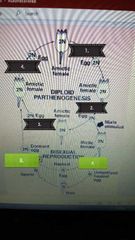
1? |
mitosis |
|
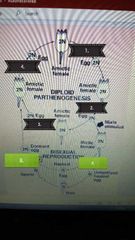
2. |
mitosis |
|
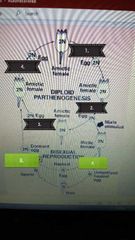
3? |
mitosis |
|

4? |
mitosis! |
|
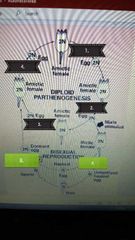
A? |
meiosis |
|
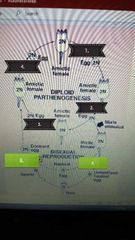
B? |
fertilization |
|
|
What taxa are unsegmented with a cuticle? |
Nematoda |
|
|
What is the difference between Nematoda males and females? |
females are larger and males have a curved end |
|
|
Guinea worms are in which phylum? |
Nematoda |
|
|
Horse hair worms are in which phylum? |
Nematomorpha |
|
|
Describe the life cycle of Nematomorpha |
1. eggs ingested by grasshopper 2. larva develops in gut 3. larva emerges when host is near water 4. develops into adult |
|
|
Are Nematomorphans monoecious or dioecious? |
dioecious |
|
|
True or false: adult nematomorphans eat vast amounts each day |
false; adults do not eat |
|
|
Gastrotrichs start of as (blank 1.) then switch to (blank 2.) with cross fertization |
1. parthenogenic 2. hermaphrodites |
|
|
Which taxon has the mastax digestive organ? |
Rotifera |
|

Which taxon has a reproductive cycle like this? |
Rotifera |

